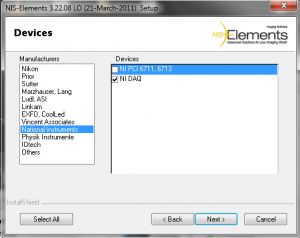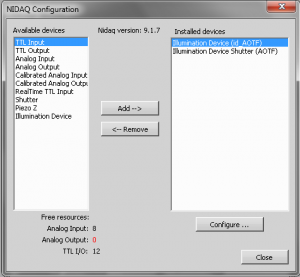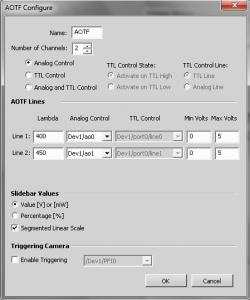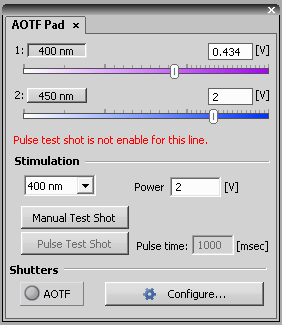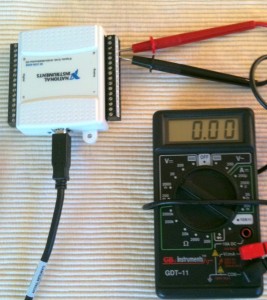
I posted briefly about this a while back, in my explanation of the demise of the parallel port. I finally got my hands on a National Instruments USB-6008 box, and have found the unit to be 100% compatible with any NI-DAQ controlling application. What follows is an example of how to set this up using NIS Elements.
First – what types of devices could be controlled with this?
- AOTF Controllers (Spectral, Neos, Etc.)
- Single Shutters (Uniblitz Etc)
- Piezo Z Controllers (ASI, MCL)
- Directly driven 0-5v lasers
- Monochromaters
- LED Light Engines (Lumencor/89 North)
So – this thing is great when compared to the PCI cards normally used for numerous reasons:
- Cost – This is ~$160 USD, vs. the PCI/PCIe cards running $1,500+
- Size – This box is quite small, doesn’t require a huge cable or breakout box, and doesn’t occupy a slot on the PC
- Portable – this will work on a mini form factor PC, or a laptop (which is what I used for this post), instead of requiring a full size tower
Installation:
Install is a snap. The only hard thing to do is place the pin indication stickers in the correct orientation on the box. If you mess this up you can always refer to the manual, but the little sticker strips included with the box make field-modification much easier. After this run the NI installer and reboot. Finally, connect the USB cable. The box will appear, and if you like, you can launch one of the NI test apps to run the device.
In Elements, we’ll re-run the installer and check the “National instruments” hardware group, then select “NI DAQ”.
Next, open Elements, open the devices window, and add the NI Device.
Once we add the device, and click configure, we can define what each of the inputs and outputs do. Here I’ve selected a 2 line AOTF.
After you’ve dialed in the settings you want, close the window(s) and if you don’t see the new device control panel, right click and select “acquisition controls” to find it. In my case the AOTF Settings window popped up after closing the device window.
I also made a short guide to using this box in elements via the Youtube video below. ***In the video I mention this thing costs $130, which is incorrect. It’s listed on the NI site as $168 as of today. Also I have yet to test more than 1 unit, but will be doing so shortly…
httpv://www.youtube.com/watch?v=poKZjRgWdhQ
One point of discussion is devices that require a 0-10v range. I’m looking into using a small powered op-amp chip and maybe packaging it into a small box for sale, or at least I’ll write up a how-to on using one, for people that need this voltage range. Luckily most of the devices out there can accept 5v or 10v input. Overall I’m happy to see NI is moving beyond PCI and PCIe bus cards. USB based boxes like these lower the acquisition cost for the customer, provide everything we need in the life science world concerning speed, and open up access to a wide array of devices. I’m looking forward to using this box on future systems!
